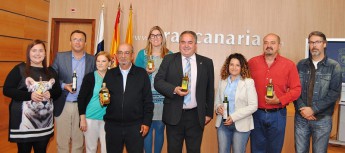 ‘Canarian olive tree’ surpassed the oil mills in the podium positions of this third tasting “Los Barros” Agüimes, which he won the second prize, and the City of St. Lucia, which he was awarded the bronze.
‘Canarian olive tree’ surpassed the oil mills in the podium positions of this third tasting “Los Barros” Agüimes, which he won the second prize, and the City of St. Lucia, which he was awarded the bronze.
The mills of the Agüimes City Council and 'Oro Canario also participated’ de Agüimes and the packaging company ‘Asoligran’ from San Bartolome de Tirajana.
The Cabildo recovered this year the Insular Oil Tasting, after not being able to perform in the 2014 because the year was disastrous in terms of production, by the warm winds at the time of flowering.
The participants of this contest were the following:
• Oil mill of the City of Santa Lucía.
• Mill of the Agüimes Town Hall.
• Mill “Los Barros”, Agüimes.
• Oil mill "Canary Gold", Agüimes.
• Mill "Olivo Canario", the Telde.
• “Asoligran” packaging machine, of Saint Bartholomew.
Gran Canaria is the island of the Canary archipelago with the largest area devoted to olive cultivation. In recent years there has been a significant boom in this crop that has turned the olive tree into a possible alternative for the maintenance and development of the southeast of Gran Canaria..
Its great adaptability to certain environmental conditions, as well as its high agronomic value, ethnographic and landscape have favored its expansion.
They are currently installed on the island 9 oil mills: 4 in Agüimes, 2 a Sta. Lucy, 2 in Telde and 1 Ingenio, in addition to a packaging plant in San Bartolomé de Tirajana. Three are municipal and the rest are private initiatives.
Although some have their own farm, almost all of them depend on the olives sold by farmers in the area who are not always the same. If we add to this the characteristics of the crop, especially of the Verdial variety, which is a very vecera variety, highly variable productions are obtained from one year to another.
The estimated production of olives is about 700.000 kilos, but taking into account that the olive tree is a very young tree and therefore varies a lot from one year to another.
Knowing exactly the cultivated area of olive trees is currently difficult, because many trees, especially the old ones, they are scattered planted as isolated feet on the edges of the plots, Although it is estimated at approximately 60.000 copies.
Of these, at least the 50% they are recently planted (two or three years), the varieties used are from the country, (Huevar verdial), the picual and arbequina, with a bit of hojiblanca, surcharge, chamomile... Crops have been registered in the municipalities of San Bartolomé de Tirajana and Agüimes, with a result of more than 14.000 olive trees, in the first and 15.000, In a second.

